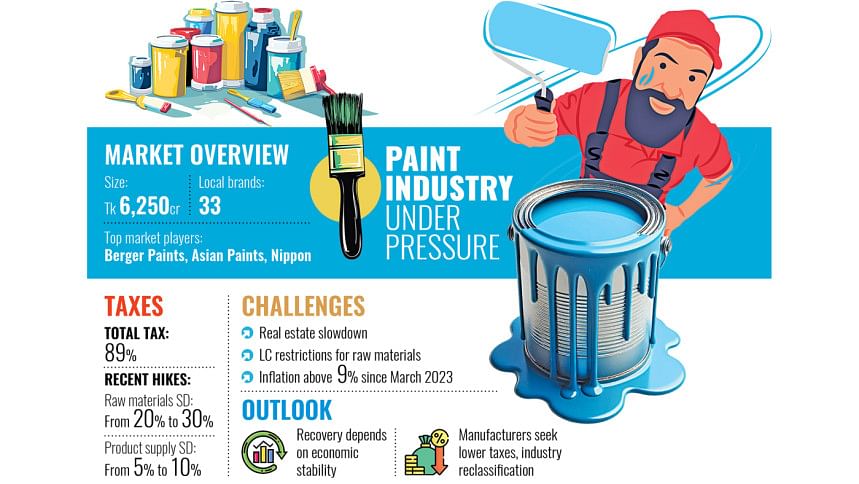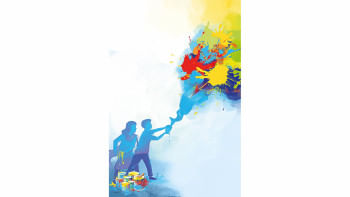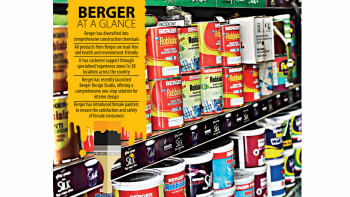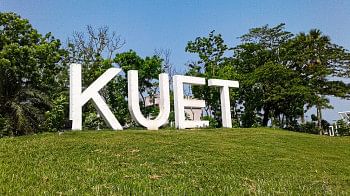Struggling paint industry looks to innovation for revival

The local paint industry is facing challenges from high taxes, rising costs, and low demand due to the ongoing economic slowdown, but innovation and eco-friendly products offer hope for a sustainable future, according to industry insiders.
The industry, which currently has a market size of around Tk 6,250 crore, has been growing alongside the country's development, which has led to an increasing number of high-rise buildings.
However, import rules and economic headwinds appear to have turned the tide.
"The paint industry is important for buildings and their longevity. But because of new taxes and rules, companies are facing big problems," said Md Quamrul Hassan, chief business officer of ACI Consumer Brands, which markets products under the brand Dulux Paints Bangladesh.
"The total tax on paint is 89 percent, which is excessive. The government should see paint as a necessity for buildings, not a luxury," Hassan said.
The future of the local paint industry depends on new ideas and eco-friendly products. With more people seeking environmentally safe paint, companies that focus on sustainability and innovation are likely to succeed in the long run
This classification means paint-makers cannot easily import raw materials since there are restrictions on opening letters of credit (LCs) for luxury imports.
"Also, the real estate sector, which is the paint industry's biggest buyer, is not doing well. Last year, paint sales went down, and high prices made it worse," he said.
He believes the future of local paint-making lies in new ideas and eco-friendly products. "People want paint that is safe for the environment and companies that make such products will succeed."
Md Mohsin Habib Chowdhury, president of the Bangladesh Paint Manufacturers' Association (BPMA), said the sector has been ailing since 2023 and witnessed negative growth in 2024 due to macroeconomic vulnerability and persistent inflation, which is above 9 percent since March of 2023.
"Local paint market completely depends on the growth of other sectors," Chowdhury said.
According to him, the National Board of Revenue (NBR) raised the supplementary duty on the import of paint and varnish-related raw materials to 30 percent from 20 percent last month. Moreover, the supplementary duty (SD) on product supply was increased to 10 percent from the previous 5 percent.
"The impact of these decisions was felt in the market immediately," he said.
However, he said the industry may rebound if the country's economy improves this year.
Chowdhury also urged the government to lower taxes and stop treating paint as a luxury good.
Kamruzzaman Kamal, marketing director at PRAN-RFL Group, which manufactures Rainbow Paints, said the paint industry tends to perform well when the construction sector performs well.
However, as the construction sector is currently underperforming, the paint industry has been suffering significantly, he added.
Furthermore, he explained that when people are in a positive headspace, they are more willing to spend money to paint their homes, leading to increased sales. However, the current situation is not favourable at all.
He said that it is uncertain whether the industry will perform better than last year.
Kamal said the recent increase in SD on paints raised prices, reduced demand and could even possibly lead to slowing economic growth. There is now a 10 percent tax on raw materials and a 5 percent tax on paint.
This makes the paint more expensive, and companies cannot easily increase prices because customers cannot afford it, Kamal said.
According to the manufacturers' association, the local paint industry can meet domestic demand.
As many as 33 local brands manufacture paint items for the domestic market. The market is led by Berger Paints, with a 54 percent share. Asian Paints has 16 percent, and Nippon Paints 8 percent.
The industry contributes to government revenue by generating over Tk 1,100 crore annually in value-added tax (VAT) and taxes.
Mainly there are two types of paint: decorative paint, with a market size of Tk 5,450 crore, and industrial paint, worth Tk 80 crore.
However, people in Bangladesh use very little paint, only 1.4 kg per person. In India, per capita paint consumption is 3 kg, and in ASEAN countries, it is 710 kg. This means there is a chance the industry can grow if the economy gets better.

 For all latest news, follow The Daily Star's Google News channel.
For all latest news, follow The Daily Star's Google News channel. 






Comments